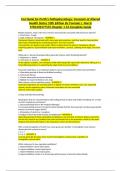Exam (elaborations)
Porth's Pathophysiology: Concepts of Altered Health States 10th Edition By Tommie L. Norris 9781496377555 Chapter 1-52 Complete Guide
- Course
- Institution
- Book
Porth's Pathophysiology: Concepts of Altered Health States 10th Edition By Tommie L. Norris 9781496377555 Chapter 1-52 Complete Guide
[Show more]



